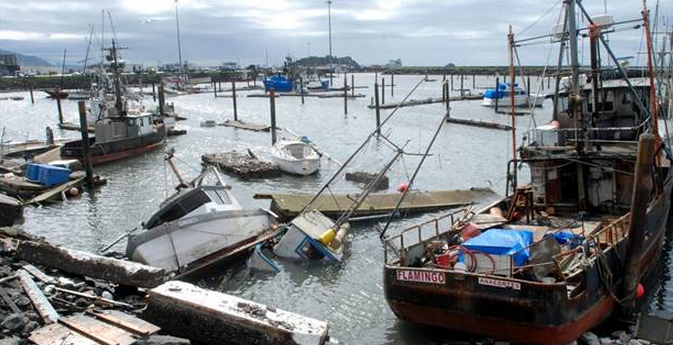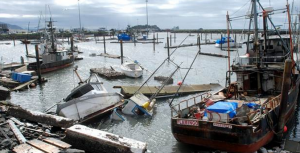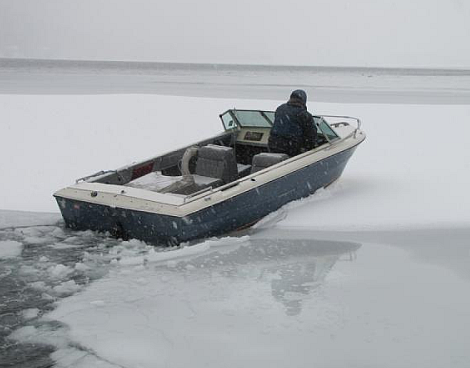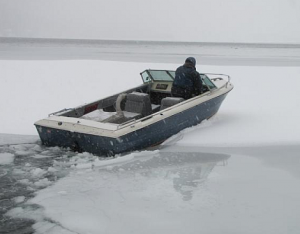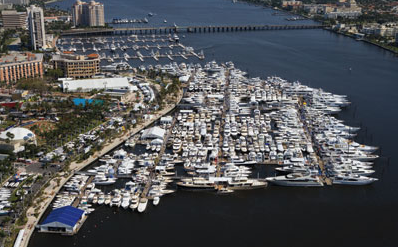
by shipyour | Nov 9, 2012 | Captains Blog

Just a day after Sandy gave a damaging visit to the New Jersey coast, hundreds of reports of damaged vessels have come in, along with reports of damaged marinas, boat clubs, boat yards, and infrastructure. With the numerous boats that have been beached, damaged or sunk by Hurricane Sandy, owners across several states await recovery.
Follow these tips to get the salvage process started quickly and to preserve whatever value the vessel may still have after Sandy.
- For a boat washed ashore, remove whatever equipment possible and bring it to a safe place to protect these items from vandals and looters. Put your contact information in a conspicuous place on the boat, and a “No Trespassing” sign to help deter unwanted visitors from your boat. Do not climb in or on a boat that is dangling from dock pilings or other obstructions, or boats that are piled up together.
- To protect your boat from more damage due to exposure to weather cover it with a tarp, or board up broken hatches or windows. As soon as you are able start drying the boat with electric air handlers, or take advantage of sunny weather. Wet cushions and other such items should be removed and dried to prevent mold and mildew, and saved for potential insurance claims.
- Submerged engines and other machinery should be flushed with fresh water and then filled with diesel fuel or kerosene, also known as “pickling”.
- For boats that are sunk or need to be moved by a marine salvage company, it is recommended that you receive approval from your insurance company before signing a wreck removal contract with anyone.
Here are some tips to salvage and get repairs done right.
Many recreational boaters have a difficult time getting the right salvage and repair help after a hurricane. There are some insurance programs that arrange everything for you, and others that will offer some help, but uninsured boaters don’t have this help.
- Steer clear of the inexperienced: Base your decision on hiring a salvage contractor on their skill and experience, not on a low-ball price. Fly-by-night operators come in to the picture far too often after situations like a hurricane, and end up causing more harm than good. Make sure to ask how long they have been doing boat salvage and repairs and ask for references. Make sure to call those references!
- The long haul: There are some signs to look for to tell if a business is in it “for keeps”. A company that is in a trade association embraces standards and acknowledges codes of ethics for the industry, which is one of the tell-tale signs to look for.
Additional Salvage and Repair Resources:
- American Boat & Yacht Council – www.abycinc.org develops standards of safety for the maintenance and repair of boats. Shops that follow ABYC standards are recommended to boat owners seeking hurricane repairs.
- C-PORT – www.cport.us The Conference of Professional Operators for Response Towing members include salvage and on the water towing companies provide training and god business practice, and establish standards for professionalism.
- Amirican Boar Builders Association – www.abbra.org is the association for shops that are dedicated to professional development, training and education, and small boat building and repair.
- Local Marine Trade organizations: There are marine trade associations with many members and in many regions that offer a range of services. Check your local businesses for membership.
While these measures and resources do not guarantee anything, they certainly can go a long way to getting things back to normal as quickly as possible after a natural disaster event like Sandy. Be safe out there! Remember that we are boaters as well, so if you are in need of additional information or resources, don’t hesitate to give us a call or email. Contact Us

by shipyour | Oct 26, 2012 | Captains Blog
Is Your Boat Ready for Winter?

While we at Ship Your Boat Now are blessed with tropical temperatures throughout most of the year, not all of our friends and client family enjoy the same warmth. The colder months are here for some of us and quickly approaching for some of the remainder.
This probably means that your boat will be sitting around just begging to be used.
While you won’t feel like or maybe won’t even be able to get you boat into the water because of the arctic blasts, you need to ensure that the call of the woods and the warmth of the fireplace don’t distract you from taking care of your baby.
Spring will be popping its green head around the corner quicker that we realize and you don’t want to be in for any unpleasant surprises.
Winterize your boat…before Old Man Winter attacks:
1. Drain and replace the oil in the lower unit of the engine. You may have water from intrusion due to the cold shrinking the seals. This could cause corrosion and possibly crack the housing. You can release a bit of oil to see if any water comes out. Check the manufacturer’s recommendations for what type of lower unit oil is recommended. Replace the plug screw sealing gaskets while you’re at it.
2. Check your batteries for correct water levels. Give good batteries a full charge before stowing for long periods so they don’t fully discharge and cause plate failure.
3. Add fuel stabilizer in the gas tank.
4. Fog the engine before you store it and after any use. It’s not a bad idea to carry around some fogging oil and apply at the end of the day.
5. If you are going to use your boat over the winter, it’s not a bad idea to leave the motor in the down position for a while after using it to allow drainage. Sometimes giving the engine a few short cranks without starting it can help push out engine water.
6. If you’re going to store the boat in extended cold you can put RV antifreeze in the lines. You’ll want to make sure the live wells and bilge areas don’t have standing water.
7. Lubricate things like the shaft on the motor and the steering assembly.
That’s some basic stuff for the boat but don’t forget your trailer. Do some bearing service and make sure to check the lighting as well. Happy boating!

by shipyour | Oct 22, 2012 | Captains Blog
The 2012 Fort Lauderdale boat show will feature more than 1,000 boats in the water and on land. The six show sites will include more than 1200 exhibitors.
The private jet traffic into the local airports turn the ramp areas into scenes from an aircraft carrier as well heeled boating and yachting enthusiasts attend this popular boat show.

Sun Sentinel, the local newspaper, featured a guide to the show.
October 20, 2012|By Steve Waters, Sun Sentinel
Attending the Fort Lauderdale International Boat Show can be overwhelming unless you have a plan.
With six sites, more than 1,200 exhibitors and miles of docks, you need to be prepared so you can get the most value and enjoyment out of the show.
When to go: The first thing you need to determine is which day or days to go.
The show always opens on a Thursday, which is known as Prime Time Preview. If you want to be among the first several thousand people to see the show, then you’ll pay the prime time price of $36 per ticket.
If being first isn’t an issue, but you are looking to make a major purchase, then a two-day ticket for $38 is your best bet. Good for any two of the next four days of the show, it allows you to comparison shop for a boat, engine, electronics, safety gear, jewelry, artwork or clothing, then come back after you’ve had time to process everything and make a final decision.
Thursday is often quite busy at the show, but Saturday and Sunday are traditionally the busiest days. Monday is the least crowded day and some exhibitors offer reduced prices on their goods just so they don’t have to pack them up and lug them back home.
Park and cruise: Getting to the show can be easy or maddening. The basic rule of thumb is to park as far away from the Bahia Mar Yachting Center, which is the heart of the show, as you can. State Road A1A by Bahia Mar is usually jammed with cars and so is Southeast 17th Street Causeway near the convention center, which has a parking garage that fills up early in the day.
The best options are to park off-site at War Memorial Park or in downtown Fort Lauderdale and take one of the free shuttle buses to the show. The buses start running at 9 a.m., an hour before the show opens each day, and continue until an hour after the show closes each day.
The most enjoyable way to get to the show is by parking in one of the city or private lots or garages at the Las Olas Riverfront and taking the free riverboat to Bahia Mar. The riverboat captains often provide an entertaining and informative narrative of the route’s history and homes.
Don’t miss: The docks along the Intracoastal Waterway have some of the world’s most magnificent motoryachts. If you’ve ever wondered how you’d spend a Powerball jackpot, check out these floating palaces. As you walk by the Swimming Hall of Fame, look on land to see the type of cars you could buy with your remaining winnings.
If a smaller boat is more your style, the Broward County Convention Center has everything from flats and bay boats to center consoles and runabouts. If you just need a new outboard motor, the latest models from all the major companies will be there.
If you’re a boat enthusiast like us then this is one you won’t want to miss out on. See you there! Be sure to come back to the Captains Blog for pics and video from the show!
